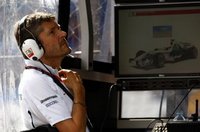 Teams must embrace KERS technology if Formula One is to survive, Honda CEO Nick Fry has affirmed following trouble-free testing of the system in Jerez.
Teams must embrace KERS technology if Formula One is to survive, Honda CEO Nick Fry has affirmed following trouble-free testing of the system in Jerez.
The Kinetic Energy Recovery Systems (KERS), which are designed to store and re-use energy lost as heat through braking and other episodes, are due to be introduced next year to make Formula One more environmentally sustainable.
But several teams, led by Renault’s Flavio Briatore, have tried to delay the introduction of the systems on the grounds of safety and cost. The concerns came after a BMW Sauber mechanic received an electric shock and a battery fire at Red Bull Racing’s Milton Keynes Factory.
However, McLaren, Williams and Honda all ran fully functioning KERS systems at the four day test in Jerez last week and experienced no major problems.
Honda’s Nick Fry is adamant that KERS is necessary to secure the future of Formula One and has criticised those teams who want to post-pone its introduction.
“KERS is key to the future of Formula One, and unless we take major steps to make the sport more environmentally sensitive, then there is no future,” he told Forumula1.com.
“I think that the teams that are arguing against KERS have got their heads stuck in the sand because it is the future, and unless Formula One adapts we’re going to be in very serious difficulties.”
Responding to criticism that the systems will be too expensive to implement Fry added that teams need to balance their priorities if Formula One is to become more affordable for smaller teams:
“We’ve got to re-orientate our expenditure to things which are useful like KERS, but away from things which are less useful such as the more obscure aerodynamic components that we spend huge amounts of time and money on.”
Honda were the first team to run their car with a version of the new KERS system earlier in the year, and in last week’s four day test at Jerez test driver Alex Wurz drove with a fully functioning 2009 specification system, alongside Williams and McLaren who are also well advanced in their development programme.
“Every time that we run with KERS, we learn more and start to fully understand its possibilities,” explains Wurz. “It’s such an interesting challenge and one that we look forward to developing further over the next few tests.”
“The test was a critical stage in our development of KERS,” added Honda’s esteemed technical director Ross Brawn. “Although installed in a ‘mule’ car, the KERS system was fully functioning and very close to 2009 specification.”
“Alex was able to give an invaluable input into the track behaviour of our KERS system and highlight several areas we need to focus on. A very valuable test and I am extremely pleased with the performance and the progress we have made with the system.”
Some critics have argued that KERS, and its related costs, will damage the racing spectacle by promoting a gap between teams that can afford to develop the technology and tailor it to their own cars, and the smaller teams who will have to become customers of the system.
There is also a fear that some teams may not be able to afford to run their cars with the technology at all which would compromise their drivers in the race and lead to a greater field spread.
“I think KERS will improve the spectacle,” contends Fry. “From what we’ve seen with our drivers they’ve rather enjoyed using KERS because it does give very noticeable boost when you hit the button and will improve the entertainment value of the sport.”
“Even though some people are obviously less keen with KERS, I believe all the teams are genius enough to develop their own systems, and whilst there will be a bit of settling down at the beginning of the season, I’m confident that everyone will come up with their own solution.”
“This technical diversity of different solutions is at the heart of Formula One; it really is the essence of the sport to encourage technical innovation and that’s something we must not lose.”






